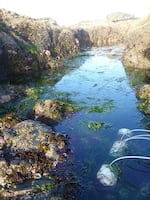
Ocean acidification sensors on the West Coast.
Oregon State University
The United States is stepping away from the Paris Climate Agreement, but the consequences of climate change will be more difficult to leave behind. Take ocean acidification, a major emerging threat to West Coast fisheries.
Researchers at Oregon State University have recorded some of the highest levels of ocean acidification in the world – and they exist right off the coast of the Pacific Northwest.
A new study in Nature Scientific Reports documents ocean acidification in the California current, which flows southward down the West Coast from British Columbia to the Baja California Peninsula.
“We know that the changes that are coming at us are pretty big,” said study lead author Francis Chan, a professor in the department of Integrative Biology at Oregon State. “We’re starting to find out every week, every month about new marine life that are going to be affected. We added Dungeness crab to that list this year.”
When oceans absorb carbon, they become more acidic. And the more carbon dioxide in the air, the more acidic they become, preventing oysters and tiny marine snails at the base of the food chain from forming shells.
“What we didn’t know is that if you’re an animal living on the shore, how often do you see a bad day? And now because we have sensors that are actually taking a measurement of ocean pH every 10 minutes throughout the summer, we can start to build that picture,” Chan says.
The study looked at three years of readings (2011-13) from tide pool and near-shore sensors along the Oregon and California coasts. It found that 63 percent of test sites experienced levels of acidification known to cause commercial oyster production failures.
The study also found that while there were persistent hot spots of destructively acidic levels, there were also areas that stayed within healthy ranges. Chan say this likely has to do with the geography of the seafloor and shoreline. He says the findings should be used in decisions about how to make fisheries more resilient to climate change.
The results also raise questions about what areas should be protected in our oceans, says OSU ocean acidification researcher George Waldbusses. Do you protect the regions most at risk? Or the areas that are holding strong against acidification?
“You may want to actually do both,” Waldbusser says. “At some level you… might want to preserve areas with better chemistry so you have systems that are less impacted.”
But on the other hand, sea life in more consistently acidic areas may be developing natural resiliency to acidic conditions.
Waldbusser says his impression is that ocean acidification is still not a central factor in this kind of decision-making.
“But I suspect it will come into those discussions more,” he says.
